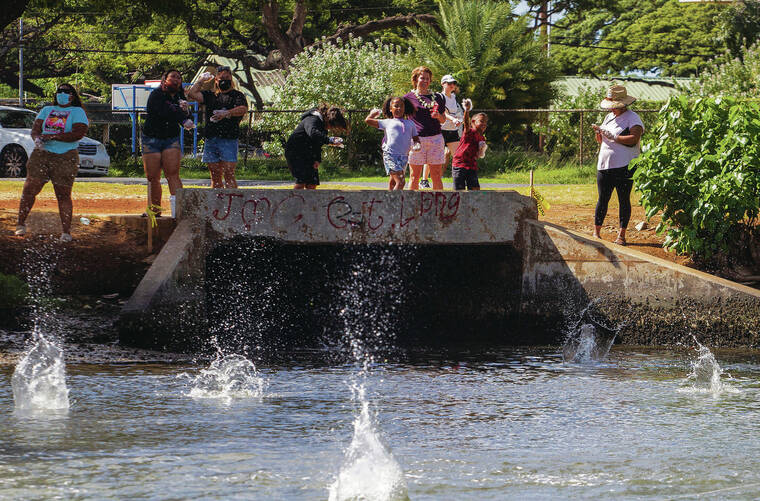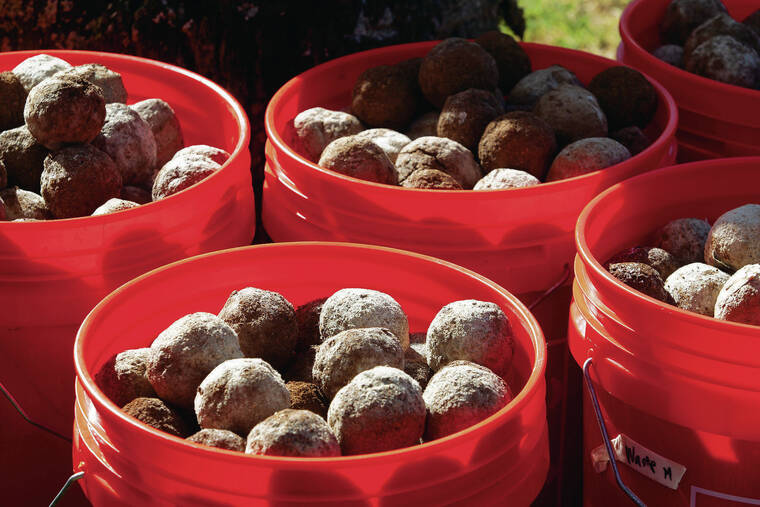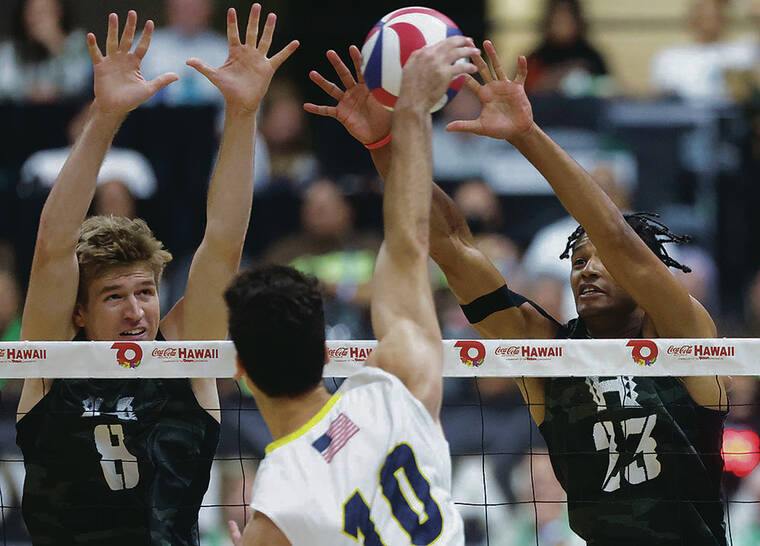Thousands of ‘genki balls’ dropped into Ala Wai

CINDY ELLEN RUSSELL / CRUSSELL@STARADVERTISER.COM
Members of the Genki Ala Wai Project and the Eco Rotary Club of Kakaako on Saturday, along with Nuuanu Elementary School students Friday, threw a total of 5,000 genki balls into the Ala Wai Canal.

CINDY ELLEN RUSSELL / CRUSSELL@STARADVERTISER.COM
Canoes were used to distribute genki balls into the Ala Wai.

CINDY ELLEN RUSSELL / CRUSSELL@STARADVERTISER.COM
Genki balls are made of molasses, soil and rice bran. They balls, which contain fermentive bacteria, digest and oxygenate sludge in the canal.



More than 200 people threw balls of mud and helpful bacteria into the Ala Wai Canal Saturday morning to help clean up sludge in the water.
In two waves — the first at around 9:30 a.m. and the second about an hour later — participants lined up around the stagnant end of the canal near the Waikiki- Kapahulu Public Library, while others hopped into a handful of canoes.
Everyone was armed with so-called genki balls — baseball-sized balls of mud, rice bran and molasses that house and feed yeast, lactic acid and phototrophic bacteria — to throw into the canal.
Including a Friday event for students from Nuuanu Elementary School, more than 5,000 genki balls were deposited into the canal over both days.
The yeast and bacteria in the balls have been shown to eat the sludge in the canal, and after a few months they make the water clearer while reducing the number of harmful bacteria.
“(The genki balls) release the microbes that actually digest the sludge that helps oxygenate the bottom, and that (allows) plankton, zooplankton and other creatures to multiply, and that naturally attracts all the fish that feed off of them,” said Hiromichi Nago, the technical advisor of Saturday’s event.
Don't miss out on what's happening!
Stay in touch with breaking news, as it happens, conveniently in your email inbox. It's FREE!
It’s not the first time genki balls have been thrown into the Ala Wai.
In November and December 2019, Jefferson Elementary School students were the first to drop the balls into the canal, and less than a year later the colony- forming units of enterococci bacteria, which can sicken people, dropped from nearly 700 to 50, according to data from the state Department of Health presented by the Genki Ala Wai Project, a nonprofit focused on cleaning the canal using the “effective microorganisms” in the genki balls.
Nago, who also serves as technical advisor for the Genki Ala Wai Project, and others including the nonprofit’s school coordinator, Mary Ann Kobayashi, hosted additional events with students to get more genki balls into the canal.
There are now about 10,000 genki balls sitting at the bottom of the Ala Wai.
While the previous drops were smaller and involved primarily students, the Eco Rotary Club of Kakaako and the Genki Ala Wai Project teamed up for Saturday’s drop to include corporate sponsors that helped finance the materials needed to make the genki balls.
“This time we wanted to make it a lot bigger and expand it … to the rest of the community,” said Jenny Do, president-elect of the Eco Rotary Club and lead organizer of Saturday’s event.
In March, about 200 volunteers helped make the genki balls. Do had worked for months to get sponsors involved and raised a total of $28,000 for Saturday’s event.
While the canal’s water quality is an issue for the community as a whole, Do also said she had personal reasons to get involved in cleaning the Ala Wai.
“I paddle outrigger canoes in the Ala Wai, and I also sail out of the Ala Wai Harbor,” she said. “I basically was kind of sick of seeing trash in the Ala Wai, and it’s a place I spend a lot of time in, so I wanted to clean it.”
A genki ball drop sponsored by businesses could become an annual event, said Daniel Shiu, financial advisor at UBS Financial Services in Hawaii, which was the title sponsor for Saturday’s drop. He said UBS will be involved in future events and hopes more sponsors will participate.
Shiu said he’s never known a clean Ala Wai Canal that’s safe for swimming.
“I grew up in Honolulu. I went to school literally on the Ala Wai, and every day I’d look at it and say, “Who would want to go in there?” he said. “I’m 53 years old and it’s always been considered a pit. … This is a great way to give back and hopefully make an improvement. If we come back year after year, it’d be nice to say we were part of it.”
In 2021, the Genki Ala Wai Project gave itself seven years to clean the canal and make it suitable for swimming and fishing, and Nago said it’s well on its way to its goal.
So far, in the area where the genki balls have been dropped, fish and birds have returned. Nago said he’s also seen turtles return to the area.
“My vision is to see a pod of dolphins come back in here,” he said. “There have been turtles … so the next one is dolphins.”
He said about 200,000 genki balls are needed for the whole canal. It would cost about $1 million to fund the balls and collect data to measure their effect.
Hawaii is the first location in the U.S. where the genki balls have been used, Nago said, although they have been used in other countries.





